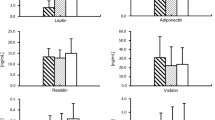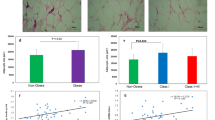The content of adipokines, pro- and anti-inflammatory cytokines were studied in adipocytes isolated from epicardial and subcutaneous adipose tissue of 24 coronary heart disease patients. The content of leptin and soluble leptin receptor in adipocytes of epicardial adipose tissue was higher by 28.6 and 56.9% and the level of adiponectin was lower by 33% than in adipocytes of the subcutaneous fat. In culture of epicardial adipocytes, the levels of proinflammatory cytokines TNF-α and IL-1 were higher. Subcutaneous adipose tissue adipocytes were characterized by higher levels of anti-inflammatory cytokines IL-10 and FGF-β. In epicardial adipocytes of coronary heart disease patients, the concentrations of leptin, TNF-α, and IL-1 were higher, while the levels of defense regulatory molecules (adiponectin, IL-10, and FGF-β) were lower than in subcutaneous adipocytes.
Similar content being viewed by others
References
Gruzdeva OV, Akbasheva OE, Matveeva VG, Dyleva YuA, Palicheva EI, Karetnikova VN, Borodkina DA, Kokov AN, Fedorova TS, Barbarash OL. Cytokine profile in visceral obesity and adverse cardiovascular prognosis of myocardial infarction. Med. Immunol. 2015;17(3):211-220. Russian.
Samorodskaya IV, Kondrikova NV. Cardiovascular diseases and obesity. Possibilities of bariatric surgery. Kompleksnye Probl. Serd.-Sosud. Zabol. 2015;(3):53-60. Russian.
Chumakova GA, Veselovskaya NG, Gritsenko OV, Kozarenko AA, Subbotin EA. Epicardial adiposity as risk factor of coronary atherosclerosis. Kardiologiya. 2013;53(1):51-55. Russian.
Alexopoulos N, Katritsis D, Raggi P. Visceral adipose tissue as a source of inflammation and promoter of atherosclerosis. Atherosclerosis. 2014;233(1):104-112.
Barbarash O, Gruzdeva O, Uchasova E, Dyleva Y, Belik E, Akbasheva O, Karetnikova V, Kokov A. The role of adipose tissue and adipokines in the manifestation of type 2 diabetes in the long-term period following myocardial infarction. Diabetol. Metab. Syndr. 2016;8:24. doi: https://doi.org/10.1186/s13098-016-0136-6.
Carswell KA, Lee M, Fried SK. Culture of isolated human adipocytes and isolated adipose tissue. Methods Mol. Biol. 2012;806:203-214.
Drosos I, Chalikias G, Pavlaki M, Kareli D, Epitropou G, Bougioukas G, Mikroulis D, Konstantinou F, Giatromanolaki A, Ritis K, Munzel T, Tziakas D, Konstantinides S, Schafer K. Differences between perivascular adipose tissue surrounding the heart and the internal mammary artery: possible role for the leptin-inflammation-fibrosis-hypoxia axis. Clin. Res. Cardiol. 2016;105(11):887-900.
Gaborit B, Venteclef N, Ancel P, Pelloux V, Gariboldi V, Leprince P, Amour J, Hatem S.N, Jouve E, Dutour A, Clement K. Human epicardial adipose tissue has a specific transcriptomic signature depending on its anatomical peri-atrial, peri-ventricular, or peri-coronary location. Cardiovasc. Res. 2015;108(1):62-73.
Hui X, Feng T, Liu Q, Gao Y, Xu A. The FGF21-adiponectin axis in controlling energy and vascular homeostasis. J. Mol. Cell Biol. 2016;8(2):110-119.
Rothenbacher D, Brenner H, Marz W, Koenig W. Adiponectin, risk of coronary heart disease and correlations with cardiovascular risk markers. Eur. Heart J. 2005;26(16):1640-1646.
Suga H, Matsumoto D, Inoue K, Shigeura T, Eto H, Aoi N, Kato H, Abe H, Yoshimura K. Numerical measurement of viable and nonviable adipocytes and other cellular components in aspirated fat tissue. Plast. Reconstr. Surg. 2008;122(1):103-114.
Vacca M, Di Eusanio M, Cariello M, Graziano G, D’Amore S, Petridis F.D, D’orazio A, Salvatore L, Tamburro A, Folesani G, Rutigliano D, Pellegrini F, Sabba C, Palasciano G, Di Bartolomeo R, Moschetta A. Integrative miRNA and whole-genome analyses of epicardial adipose tissue in patients with coronary atherosclerosis. Cardiovasc. Res. 2016;109(2):228-239.
Venteclef N, Guglielmi V, Balse E, Gaborit B, Cotillard A, Atassi F, Amour J, Leprince P, Dutour A, Clement K, Hatem S.N. Human epicardial adipose tissue induces fibrosis of the atrial myocardium through the secretion of adipo-fibrokines. Eur. Heart J. 2015;36(13):795-805a.
Wu FZ, Wu CC, Kuo PL, Wu MT. Differential impacts of cardiac andabdominal ectopic fat deposits on cardiometabolic risk stratification. BMC Cardiovasc. Dis. 2016;16:20. doi: https://doi.org/10.1186/s12872-016-0195-5.
Author information
Authors and Affiliations
Corresponding author
Additional information
Translated from Byulleten’ Eksperimental’noi Biologii i Meditsiny, Vol. 163, No. 5, pp. 560-563, May, 2017
Rights and permissions
About this article
Cite this article
Gruzdeva, O.V., Akbasheva, O.E., Dyleva, Y.A. et al. Adipokine and Cytokine Profiles of Epicardial and Subcutaneous Adipose Tissue in Patients with Coronary Heart Disease. Bull Exp Biol Med 163, 608–611 (2017). https://doi.org/10.1007/s10517-017-3860-5
Received:
Published:
Issue Date:
DOI: https://doi.org/10.1007/s10517-017-3860-5




